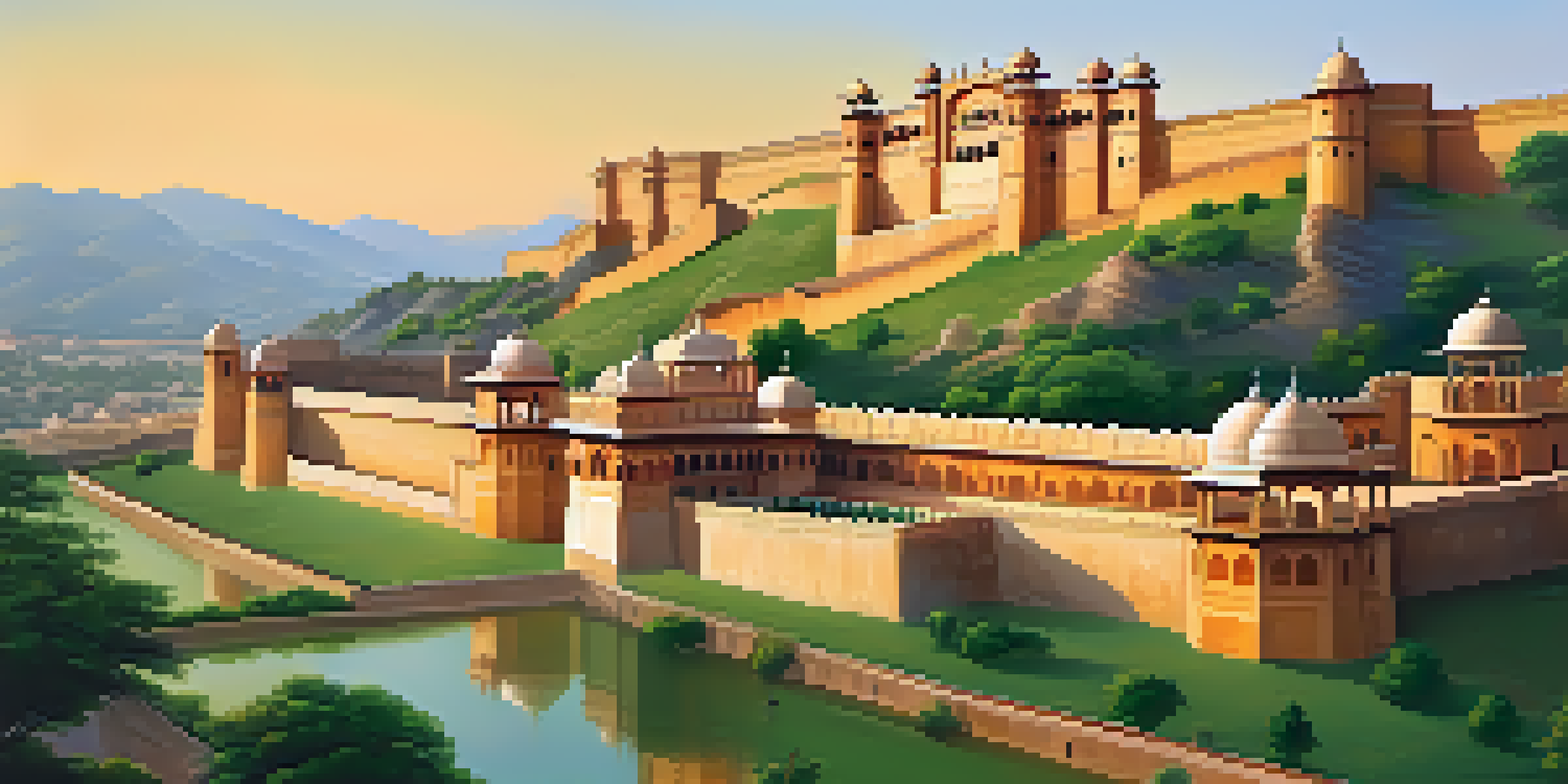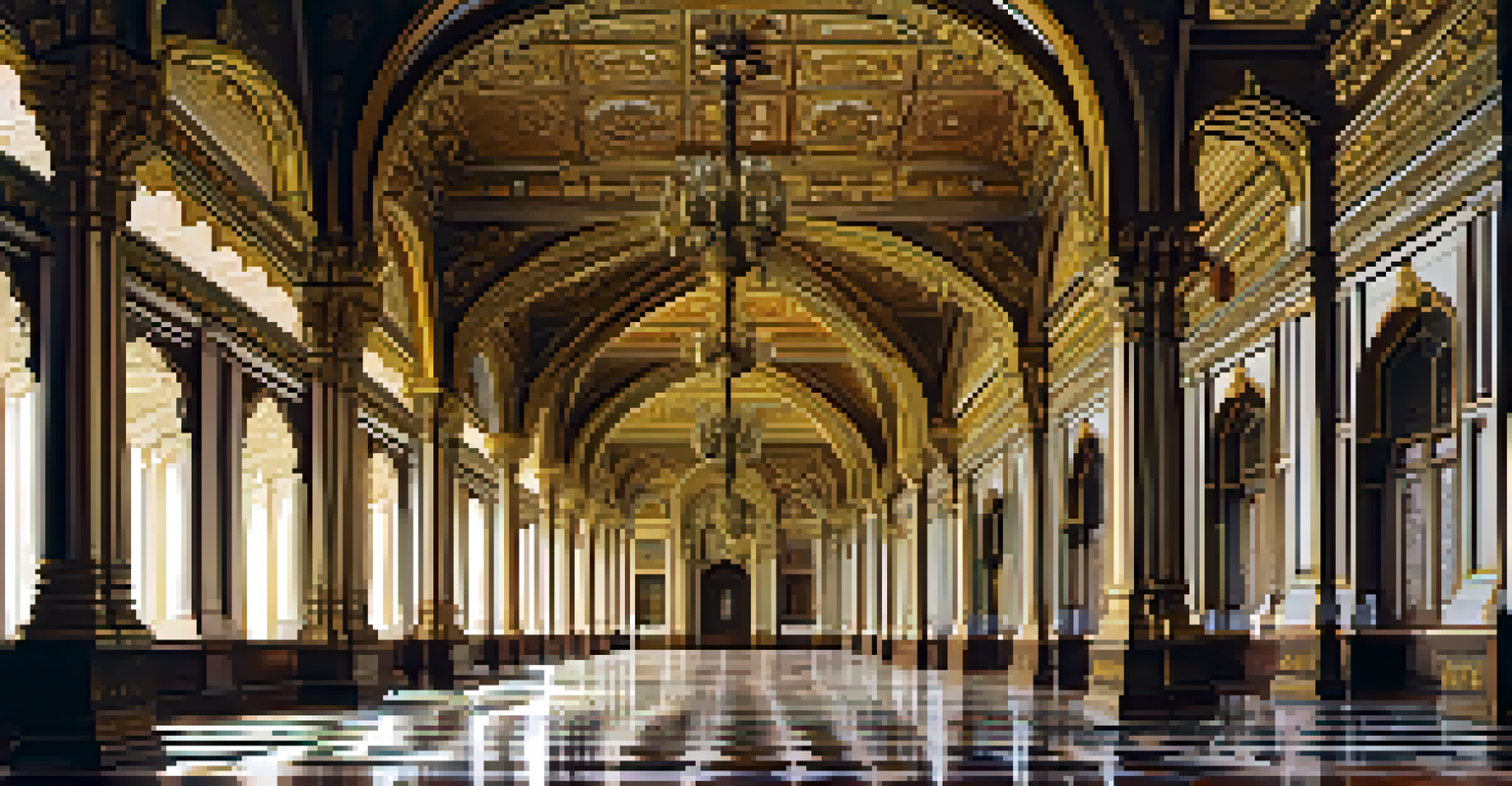Exploring India's Forts and Palaces: A Cultural Heritage Tour

The Architectural Marvels of India’s Forts
India's forts are not just structures; they are stories etched in stone. From the towering walls of the Red Fort in Delhi to the imposing Mehrangarh Fort in Jodhpur, each fort reflects the architectural prowess of its time. The intricate carvings, expansive courtyards, and strategic locations all tell tales of battles fought and victories won.
Architecture is the art of how to waste space.
These forts often served as the heart of cities, acting as a protective stronghold for rulers and their subjects. For instance, the Kumbhalgarh Fort, with its massive walls, was built to defend against invasions, showcasing both beauty and utility. Exploring these forts gives us a glimpse into the military strategies and lives of those who once inhabited them.
Walking through these ancient structures, you can almost hear the whispers of history. The blend of cultural influences—Hindu, Mughal, and colonial—creates a rich tapestry that is uniquely Indian. Each fort invites you to step back in time and imagine the grandeur of royal processions and the daily lives of kings and queens.
Palaces: A Glimpse into Royal Life
India's palaces are often the epitome of luxury and artistry, designed to showcase the wealth and power of royalty. The City Palace in Jaipur, with its stunning courtyards and museums, is a prime example where every room is filled with artifacts and paintings that narrate royal stories. These palaces were not just residences; they were centers of governance and culture.

Visiting places like the Mysore Palace, famous for its exquisite architecture and opulent interiors, allows you to experience the splendor of royal life. The vibrant colors, intricate designs, and the rich history behind each room captivate visitors. It's like walking into a living museum where every corner holds a piece of the past.
India's Forts: Stories in Stone
India's forts are not just architectural wonders; they embody the rich history and cultural narratives of the regions they inhabit.
Moreover, many of these palaces host festivals and cultural events, offering visitors a chance to engage with local traditions. For instance, the Pushkar Camel Fair near the Amar Mahal allows you to experience the vibrant culture of Rajasthan. These events not only preserve history but also invite you to be part of it.
The Cultural Significance of Forts and Palaces
Forts and palaces are more than just architectural feats; they are cultural landmarks that signify the heritage of India. They serve as reminders of the diverse traditions and histories that shape the Indian identity. Each structure reflects the unique cultural influences that have permeated through centuries, offering insight into the lives of various communities.
Every building is a monument to the past, a record of the people who built it and the world they lived in.
For instance, the intricate frescoes of the Hawa Mahal in Jaipur depict the lifestyle of the royal women, showcasing the importance of art and culture in everyday life. Such details highlight the significance of these structures beyond their physical grandeur, emphasizing their role in storytelling and preserving culture.
Furthermore, these sites attract tourists from all over the world, contributing to local economies and fostering cultural exchange. By promoting awareness and appreciation of our heritage, we ensure that the stories of these forts and palaces continue to inspire future generations.
Exploring the Forts of Rajasthan
Rajasthan is home to some of the most majestic forts in India, each with its unique charm and history. The Amber Fort, with its artistic blend of Hindu and Mughal architecture, offers stunning views of the surrounding hills. The fort's intricate designs and beautiful gardens make it a popular destination for tourists and history enthusiasts alike.
Another gem is the Chittorgarh Fort, which is not only one of the largest forts in India but also a UNESCO World Heritage Site. Its many palaces, temples, and towers tell tales of bravery and sacrifice, particularly the legend of Rani Padmini, which is ingrained in the local culture. Exploring these fortifications gives visitors a deeper understanding of Rajasthan's regal past.
Palaces Showcase Royal Heritage
The opulent palaces of India reflect the grandeur of royal life and serve as cultural centers that preserve traditions and history.
Moreover, the forts often host light and sound shows that bring history to life, allowing visitors to engage with the past in a unique way. These experiences make your visit unforgettable, painting a vivid picture of what life was like during the time of kings and queens.
The Enchantment of Mughal Architecture
Mughal architecture is renowned for its grandeur and intricate artistry, and India's forts and palaces are prime examples of this style. The Agra Fort, a UNESCO World Heritage Site, showcases the might of the Mughal Empire with its massive red sandstone walls and stunning marble interiors. Each corner of the fort exudes an aura of history and elegance, inviting you to explore its royal past.
The Taj Mahal, though primarily known as a mausoleum, is part of a larger complex that includes forts and palaces reflecting Mughal design principles. The symmetrical gardens and reflective pools create a serene atmosphere, making it a perfect example of how architecture and nature can coexist harmoniously.
Exploring these Mughal sites allows you to appreciate the fusion of Persian, Indian, and Islamic styles. The attention to detail in decorative art, geometric patterns, and calligraphy tells a story of cultural richness and artistic achievement that continues to influence architecture today.
The Role of Forts and Palaces in Tourism
India's forts and palaces play a pivotal role in attracting tourists from around the globe. They are not only historical landmarks but also vibrant centers of cultural exchange. With millions of visitors each year, these sites contribute significantly to the local and national economy, offering jobs and promoting crafts and traditions.
Tourism initiatives often include guided tours, heritage walks, and interactive experiences that engage visitors in the history and culture of these majestic structures. For instance, the sound and light shows at the Red Fort narrate the rich history of Delhi, captivating audiences with stories of the past.
Conservation of Cultural Heritage
Efforts to conserve India's forts and palaces are essential for maintaining their historical significance and ensuring they are preserved for future generations.
Moreover, these sites inspire a sense of pride among locals and serve as a reminder of India's rich heritage. By visiting, tourists help preserve these historical treasures and ensure that the legacy of India's forts and palaces continues to thrive for generations to come.
Conservation Efforts for Heritage Sites
As custodians of history, preserving India's forts and palaces is crucial for future generations. Various organizations, both governmental and non-governmental, work tirelessly to restore and maintain these heritage sites. This includes not only structural repairs but also efforts to ensure that the cultural narratives associated with these sites are kept alive.
For example, the Archaeological Survey of India (ASI) plays a key role in the conservation of many historical sites. Their initiatives often involve using traditional materials and techniques to maintain authenticity while also integrating modern restoration methods to prevent decay.

Community involvement is also essential in these conservation efforts. Local artisans and craftsmen contribute their skills and knowledge, ensuring that restoration efforts are respectful and culturally relevant. This collaborative approach not only helps in preserving the sites but also fosters a sense of ownership and pride among the local community.